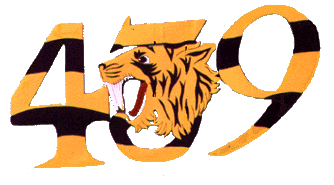|
History
of
 Squadron Squadron
  
Chapter
VI
Winter in the Netherlands
November 1944 January
1945
|
Not all were able
to find shelter in time to escape the starffing, although on the whole it was remarkable that casualties werr so few No.439 escaped with five men wounded.
Sgt.R.H.Cappelman,
Cpl.M. Singerman(the orderly room clerk) and LACs J.T.Bews and Crinklaw (the last named a member of 6439 Servicing Echelon) suffered minor
shrapnel wounds. The most seriously injured was F/L Hart Massey, the squadron intelligence officer, who received multiple injuries to the head, chest and back when his shack was riddled by enemy fire. The pilot's crew room was also hit by 20 mm. shells, one of
which trimmed the peak off F/O Lyal Shaver's cap. Further damage was done by the explosion of 1000 lb. bombs stored on the airfield which
shattered windows, loosened walls and blew doors open. For almost an hour the blasts continued until even "Pitchdark", one of the pups, got
"the twitch."
(1).
(1) A few days later it was necessary to shoot the poor pup which
had become paralysed.
|
Intentionally
left blank
|
|

F/O RH Laurence,
DFC (Portrait by F/L
PA Goranson, WWII artist - scanned from The Roundel)
|
It
will be recalled that four pilots were out on a weather recce when the
attack began. After surveying the American battle front they flew north to
the Munster area and then returned homeward. They had just reached the Rhine
when they heard over the R/T that enemy fighters were heading eastward from
Eindhoven. Near Deurne, about 15 miles from their base, the four Typhoons
intercepted the
enemy, about 15 to 20 FW.190s flying at various heights from 500 to 1000
feet. One or two Spitfires were engaging the aircraft and F/O Laurence's
section joined the dogfight.
After
considerable maneuvering Bob got on the tail of one 190 and closed in.
"He didn't
take much evasive action and I gave him a short burst with about five
degrees deflection turning slightly starboard. I saw strikes, mostly on the
starboard wing, and then gave another short
burst getting more strikes on the wings and some on the fuselage. This time
the aircraft rocked a little and started towards the ground as if out of
control. At this point I had to break port with an FW.190 on my tail and
firing at me. When next I looked in this direction I saw an enemy pilot
descending by parachute. My No. 2 saw at least three or four aircraft go in
at this point and at this time." Laurence's
Focke Wulf was confirmed as probably destroyed. His report went on: "The
fighting continued and I had one or two short bursts at other aircraft but
did not see any results.
As the action broke off I saw one FW. 190
turning away from me and I was able to close from 75 to 100 yards dead astern. I gave it a short burst, then another short burst, getting strikes both times; the second time the coupe top and several other pieces blew off. It dropped its nose and went towards the ground, rolled slowly over on its back, and crashed into a
brick building and burst into flames. "
|
|
This aircraft, it was later learned, was flown by a senior German officer who had led the air assault. F/O A.H. Fraser, flying number two to Laurence, also accounted for two Focke Wulfs, both confirmed as destroyed. When his leader engaged the enemy Hugh tried to stay with him, but gradually fell back as Laurence made extremely sharp turns.
"My
leader got on an FW. 190's tail and another 190 slipped in on his tail. The FW. on my leader's tail could not turn as tight as my leader so he broke the other way. By this time I was about 75
-100 yards behind. I gave him a short burst at ten degrees angle off and airspeed about 190 200 m.p.h. Pieces flew off his aircraft, he caught fire, turned over on his back and went straight in near
Deurne. By this time I had lost my leader. Somebody took a squirt at me from 45
degrees angle off, judging from the holes in my aircraft. At this time I saw four aircraft hit the ground and one
parachute. I was then at about 1500 feet and saw a long nosed FW. 190 in a shallow dive underneath me, going towards Venlo. I dived after him, closing rapidly, and when he was about 100 feet above the ground took four short bursts at him. It was line astern shooting and my last burst was from about 50 yards. Pieces flew off the aircraft. I must have severed his elevator controls because he never levelled off. He went into the deck somewhere near a large
windmill east of Deurne. I had to break very quickly to avoid hitting him. I saw him hit the ground at approximately 400 m.p.h.; pieces flew in every direction. "
  
Copyright
©1998-2016 Michael T. Melnick. All rights reserved
the
unofficial homepage of  Tiger
Squadron Tiger
Squadron
.
.
|
|